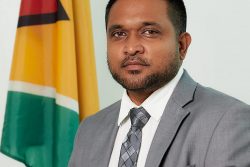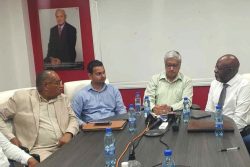Editor’s Note: The following is an edited and abbreviated version of the Tribute given at the Funeral Service for Robert John (Bobby) Fernandes, which was held on March 1st.
I extend on behalf of myself and my family and all those from the hinterland, the rural areas of Guyana and those from overseas – scientists and explorers, who knew and interacted with Bobby – sincere condolences to your family on his transitioning and pray that you be comforted in his physical absence by the happy and treasured memories of the love and the personal and private experiences you shared with him.
The Almighty knows best, and Bobby’s family should rest assured that it was humanly impossible for you to do any more than you did to love, care for and to prepare for the inevitability of his transitioning but you should also rejoice that Bobby is in a good place and I am sure is with us in spirit. He will want us not to mourn his loss but to be thankful to God for him and the life that he lived, and to celebrate the immense contributions and rich legacy that is now yours and ours to safeguard and take forward.
I am honoured to have been asked by his beloved wife, Luana, to pay this Tribute to my friend for half of a Century, Robert John Fernandes – our Bobby. It is appropriate that this Service of Thanksgiving for the life that he lived is held under the theme “A Life Well Spent.” Bobby indeed spent his 74 years in a multi-dimensional and multi-faceted manner. He did it his way – with zest, vigour and vitality and even though in his later years his physical abilities were limited by his debilitating illness, he demonstrated courage and resilience, buoyed by the unconditional love and absolute dedication shown by Luana, the affection and attention of their children, Christina, Robert, Dominic, Damian, Shad, Nicolette and Chantalle, the expertise of medical personnel and care givers, and the prayerful support of their religious counsellors, extended family, friends and well-wishers.
Bobby had a life-long passion for Guyana, the land of his birth, for its people, landscapes and biodiversity. He excelled at nature photography, a vocation in which he was an acknowledged expert having commenced in 1969. It is said by those knowledgeable that he had the ‘eye’. Over the years, he exhibited his photographs nationally, regionally and internationally, especially in countries where we have a strong Diaspora presence. I am sure as they viewed his photographs, they were filled with nostalgia for the Guyana where their navel strings are buried. Maybe Bobby’s craftsmanship and narration, imbued in them the desire to return, if not to stay, at least to visit those landscapes that Bobby so expertly captured on film.
After 25 years as a photographer travelling the length and breadth of Guyana, he decided to write his first poem because, as he said in a presentation in 2012 at Moray House, “photos could not describe the emotions I experienced when encountering the extreme beauty of Nature at close range, so I turned to poetry to complete my description of Nature that I had started with my photos.”
His writings recorded his keen observation of nature and the human condition, and his unselfish and respectful relationship with human beings from all walks of life.
He loved his family deeply and they reciprocated this affection, which, for those who were privy to their relationship, was profoundly inspiring and motivational – it was natural and uninhibited, and they drew strength as a family from this closeness.
I treasure the memories I have of him. At Orinduik, fifty years ago, I was visiting troops at the Border Outpost in 1971 and saw his boat tied up at the Landing in the Ireng River above the magnificent Orinduik Falls. He would have travelled down from his idyllic, rustic homestead near Cipo Mountain, further upstream in the breathtaking, scenic wonderland of the north western Pakaraimas, to collect supplies and mail. I was told that he was at Mrs Correia’s shop, I knew that I was in for a treat – Mrs Angela Correia, the Queen of Orinduik, with her endless reminiscences of the high society life in Georgetown, and then there would be Bobby, waxing lyrical about his travels in the upland savannahs of the north Pakaraimas and of the emerald and turquoise pools, in which he delighted. Have a look at the book of his 99 Best photos and look for the one titled “Rainy Season at Cipo,” and you will understand what I mean. When I arrived at the shop and met them both, I was not disappointed.
In 1973, our paths again crossed when Bobby was highly recommended by Guyana’s foremost botanist and explorer, Adrian Duncan Thompson, as an experienced traveller in Guyana’s hinterland and expert nature photographer, to accompany the joint Guyana-UK Roraima Expedition co-led by Thompson and Hamish McInnes, and in which I had a reconnaissance and logistics coordinating role. This expedition supported the team of four expert UK mountaineers who were the first to successfully complete the ascent of the Great Northern Prow of Roraima and whose exploits were recorded in McInnes’ book, titled “Climb to the Lost World.”
Then we interacted at Karanambu when I was Chairman of the Karanambu Trust, and where Bobby had a fascination with the marvellous conservation work of Ms Diane McTurk, the Otter Lady, and her rehabilitation of orphaned Giant Otters and returning them to the wild in the Rupununi River.
Bobby also had an easy and respectful relationship with the ‘pork knockers’, lumber men, shingle makers, boat builders and with the Amerindian communities, where he made lasting friends and assimilated aspects of the traditions and cultures of the Patamonas of the Pakaraimas and the Potaro, the Arecunas and Akawaios of the upper Kamarang and upper Mazaruni, the Macushis and Wapishanas of the north and south Rupununi and the Arawak/Lokonos of the coastal and riverain communities.
His interactions with the hinterland, rural and urban communities are captured in his Collection of Guyanese stories and fables, “Short and Sweet,” published in 2008.
In “Birds of Guyana,” he collaborated with Guyanese Zoologist, Ornithologist and Taxidermist Balram Singh to produce a detailed introduction to some of the more fascinating species of birds to be found in Guyana; and, in “The Voice and Vision of Robert J Fernandes,” an unexpected adventure published in 2014, he produced his first collection of poems, which are considered “patriotic, unflinchingly introspective, and… an important addition to anyone’s bookshelf.”
In both “Short and Sweet,” and “The Voice and Vision of Robert J Fernandes,” Bobby credited our own distinguished artist, sculptor, author, poet and classical guitarist Stanley Greaves, another St Stanislaus student and then Master, and a lifelong friend of his family, for teaching him about writing and poetry, for recognizing the potential of his stories and encouraging him to write them down. Not surprisingly also, Bobby dedicated these books to Luana and their children, writing that they filled his life “with beauty and meaning”. There is always as the recurring theme in his photography and his poems, his love for his family and the Love of his Life, his beloved Luana. In this hauntingly beautiful poem in “Voice and Vision” (p 45), he laments the fact that whenever he went back to the Pakaraima Mountains and their homestead at ‘Cipo’ without Luana, emptiness overwhelms the natural beauty of the landscape.
Orinduik Lost
Today I walk alone where
once young hearts were clasped,
memories echo from majestic mountains.
Now, only mole hills cluttering the horizon
as waving grass answers the
mocking questions of the wind.
I bend to sip a familiar stream
but laughing waters play among the
rocks of my loneliness.
The blue pool reveals its true identity
with the sadness of my solitary reflection,
even the gentle waterfall stems its flow
protesting another season without you.
Only clouds with cosmic wisdom seem
to know and weep a rainbow
to fuse our souls together.
(2001)
My relationship with Bobby evolved over the years from our initial meeting in 1971, as you had to earn his respect and friendship. To my great satisfaction, this enduring respect and friendship can be deduced from his inscriptions in the books he gifted me. The inscription in his “Short and Sweet” stated matter of factly: “To Joe, Best wishes”. Robert J Fernandes, 2008. A year later, his inscription in “Birds of Guyana” reads: “To Joe. A True Guyanese”. Bobby, June 2009. And then his inscription in “The Voice and Vision of Robert J Fernandes” reads: “To Joe. You share my love of Country”, Bobby. August 2014.
I believe what had cemented our relationship was his experience in evaluating the depth of my commitment to the success of a challenging mission. In 1992, when I was Chief of Staff of the Guyana Defence Force, Bobby arrived outside of our home, at that time in Lamaha Gardens, just after 7 a.m. and apologized for being there so early as he said he was ‘close marking’ me from the time I left Camp Ayanganna after morning physical training, in order to catch me before I got absorbed in the day’s activities. He placed in my hand a brown, sealed envelope in which was a manuscript that he felt I should look at because of its importance to Guyana. If I agreed with his assessment that it was of importance to Guyana, then he challenged me to have it published.
He then said goodbye and departed. I was subsequently able to peruse the manuscript, which was an account by British Guianese Sworn Land Surveyor Caesar Peter de Freitas, (1889-1967), who had been appointed in 1931 by Governor Sir Edward Denham to join the British Team assigned to finally fix the frontier markers between the United States of Brazil and British Guiana, and jointly with the Brazilian and Venezuelan Boundary Commissioners, to fix the Tri-Junction Point on the summit of Roraima.
I knew the value of the document and set about getting permission to publish from de Freitas’ sole survivor – his daughter, Sister Alida de Freitas, a Nun at the Loreto Convent in Canada. I had to go to Canada, meet with her at her Convent, and swear to an Affidavit that the publication was going to be used for historical, educational and charitable purposes only. Funds had to be raised from the private sector and arrangements made for printing five hundred (500) copies of the book to be distributed to the donors who provided funds and to the main libraries in Guyana, as well as to key Ministries such as the Ministry of Foreign Affairs. The project was completed within a year and to the satisfaction of all concerned. Bobby was elated and especially so, when he saw that in the Foreword of the publication, I acknowledged his role in bringing the manuscript to my attention. It is serendipity that the same week when Bobby passed away, I received an enquiry from Sir Shridath Ramphal as to whether I knew of any documented reference to the conduct of the Tri-Junction Survey on the summit of Roraima. I responded immediately that the book I published in 1993, titled “On the Frontier of Guyana-Brazil,” based on the manuscript of Caesar de Freitas given to me by Bobby in 1992, provided that evidence. I scanned the relevant pages and sent them to Sir Shridath.
It is said that at the moment of death, the soul departs from the body as a bird from a broken cage and wings its way on an immortal journey through worlds of joy and unending progress.
So let it be for Bobby.





